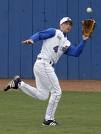Footwork for outfielders
March 13, 2011 by Coach McCreary
Filed under Outfield
 |
| Avoid drifting when possible. |
When it comes to baseball instruction, I’ve always been a fan of taking a “ground up” approach. That means everything I teach starts with the feet. I believe most problems with hitting and fielding originate with footwork mistakes. So when I discuss playing outfield, proper footwork is my first priority. The following three parts are a progression of how I teach outfield footwork. When an outfielder masters the first one, I then move him onto the next.
 |
| Square up to the infield. |
Square up. By the time outfielders reach high school, many of them know the importance of trying to “square up on the ball.” This means when a fly ball is hit to them, the outfielder tries to hustle under the ball, square up their shoulders/hips/body to the infield, and make the catch. Doing this when possible prevents the outfielder from drifting or coasting away from the infield as he makes the catch. Drifting forces the outfielder to stop his momentum after the catch, change directions, gather more momentum, and then make the throw. A player who hustles and squares up has already stopped their movement away from the infield and only need to catch and throw. Less footwork after the catch = quicker release back to the infield.
Behind the ball. When an outfielder consistently squares up on fly balls, the next piece of footwork involves getting behind the ball. I mentioned above that when an outfielder squares up he stops his momentum away from the infield before he makes the catch. This saved valuable time. However, after the catch the outfielder still has to generate momentum before throwing. This is where getting behind the ball can solve this dilemma. An outfielder who has quicker footwork can not only square up to the infield on a fly ball but can also move back a few steps behind the ball. This allows the outfielder to move forward to catch the ball instead of catching the ball standing still. Moving forward to catch generates momentum towards the infield before catching the ball. The outfielder only needs to catch and throw without first wasting valuable steps to generate some momentum.
 |
| Although the timing isn’t perfect, Juan Pierre gets behind the ball and leads with the proper foot to catch. |
Lead with the proper foot. The last phase of this progression will allow the outfielder to use less steps after they catch the ball in order to throw back to the infield. A right handed outfielder should always try to catch the ball with his left foot forward. A left hander should lead with his right foot forward. Let’s pretend a right hander does it wrong and leads with his right foot. After catching he will need to step with his left foot, then his right foot – usually a hop/crow hop – and then finally his left foot again to throw. That’s three steps after catching. A right hander that properly leads with the left foot forward on the catch only needs to cross/hop in front with his right foot and step to throw with his left again. That’s two steps after the catch. One less step. The timing of the proper step forward is equally important. When a right hander leads with his left foot forward he must time it so his left foot is landing at the exact same time the ball hits his glove. This takes some practice but the proper timing of both together allow for a quicker and more powerful throw because everything (footwork, catching, throwing) is in the proper rhythm.
If you are an outfielder or a coach of outfielders, be sure to give the proper focus to footwork. Usually improvements are made pretty rapidly once you do.
Note: The same footwork – timing and proper foot forward to catch – applies to catching balls hit on the ground to outfielders as well.





Leave a Reply